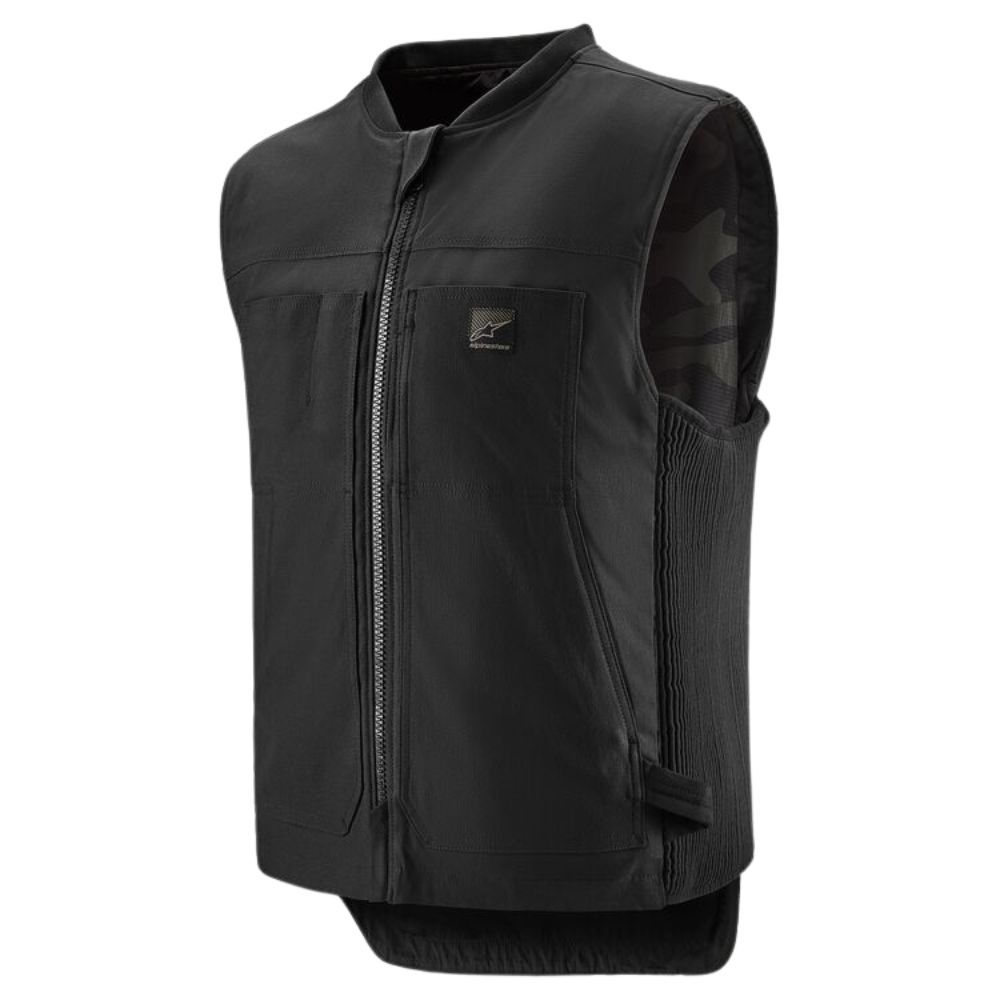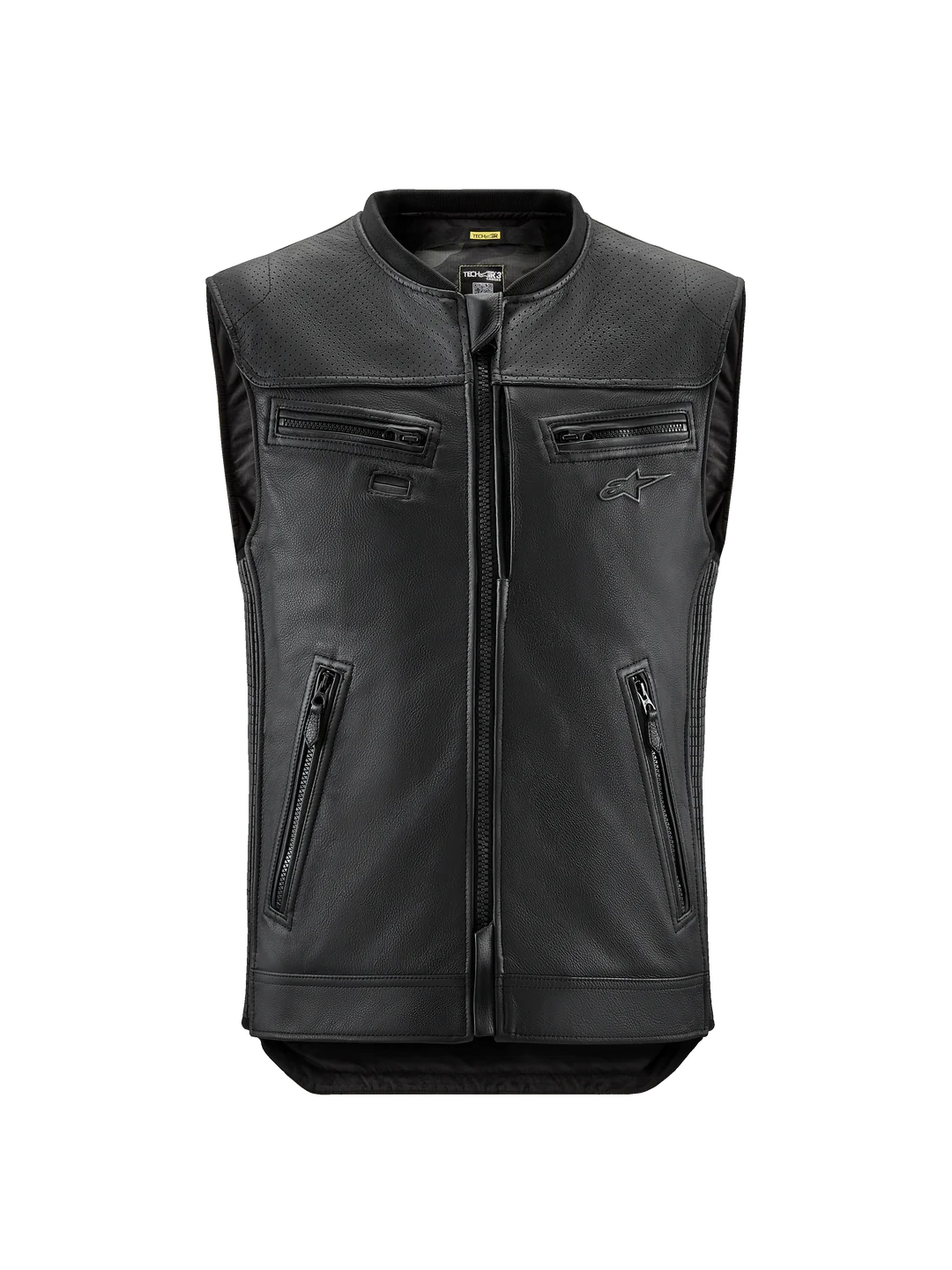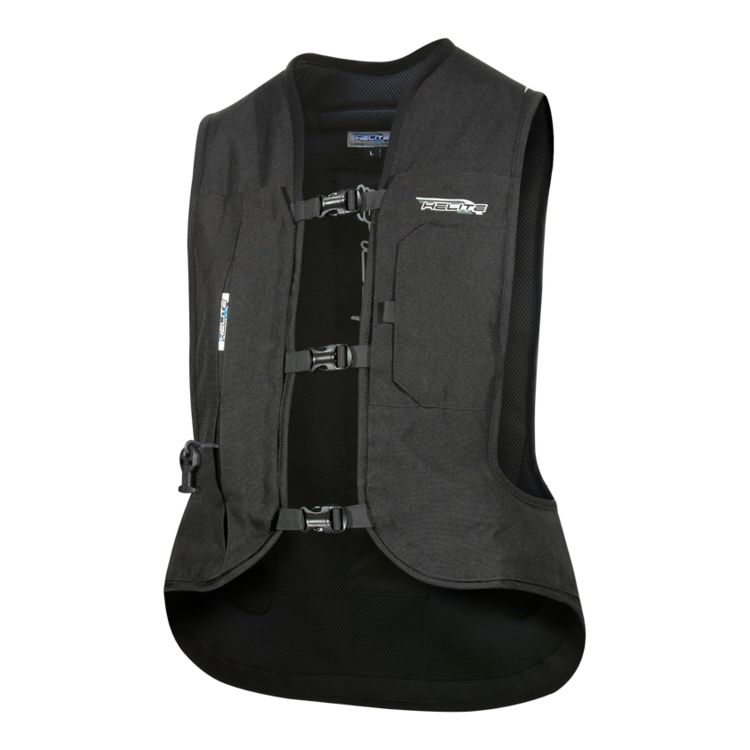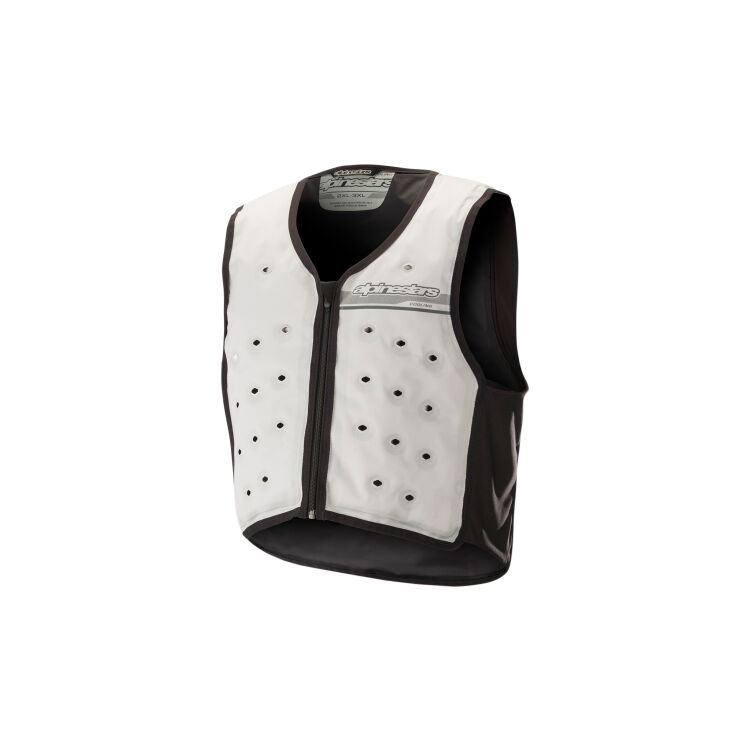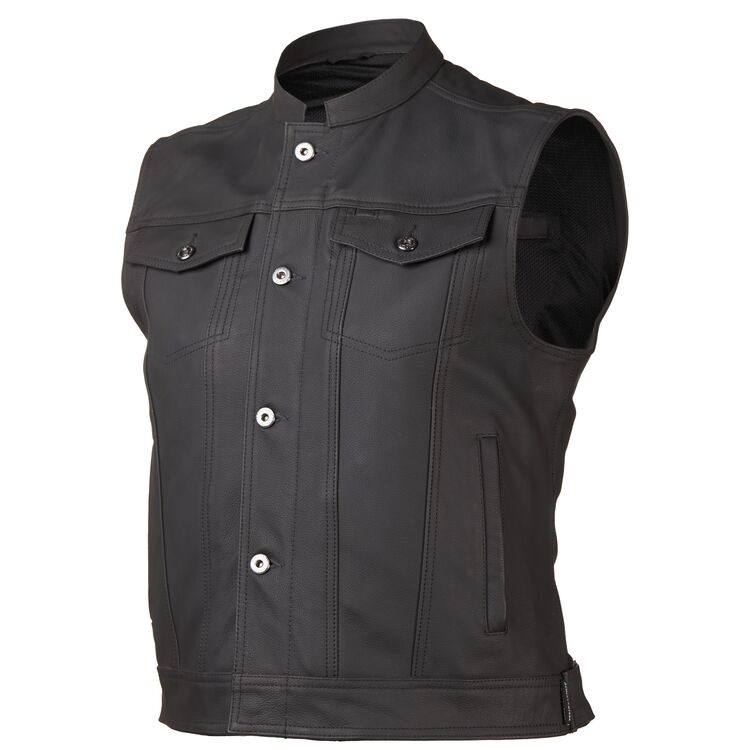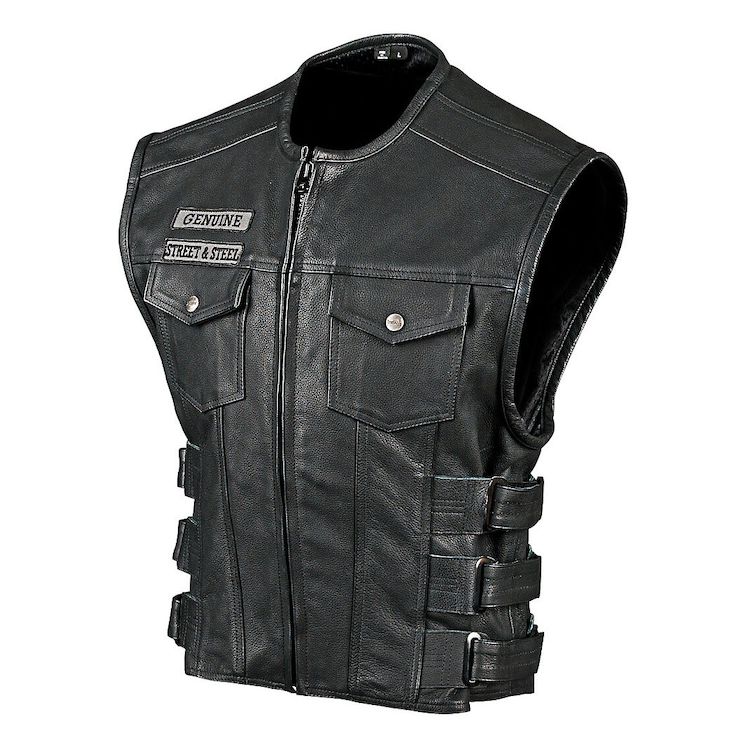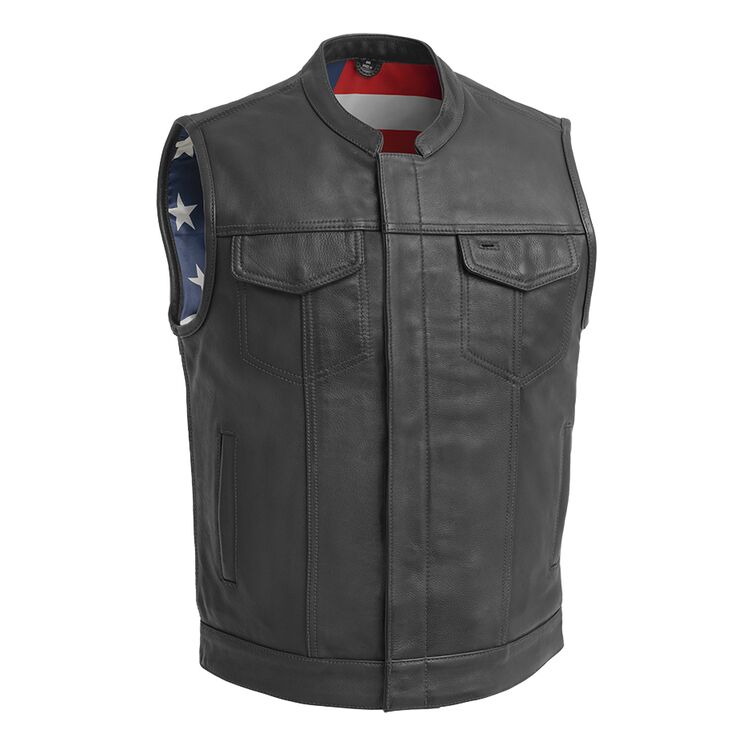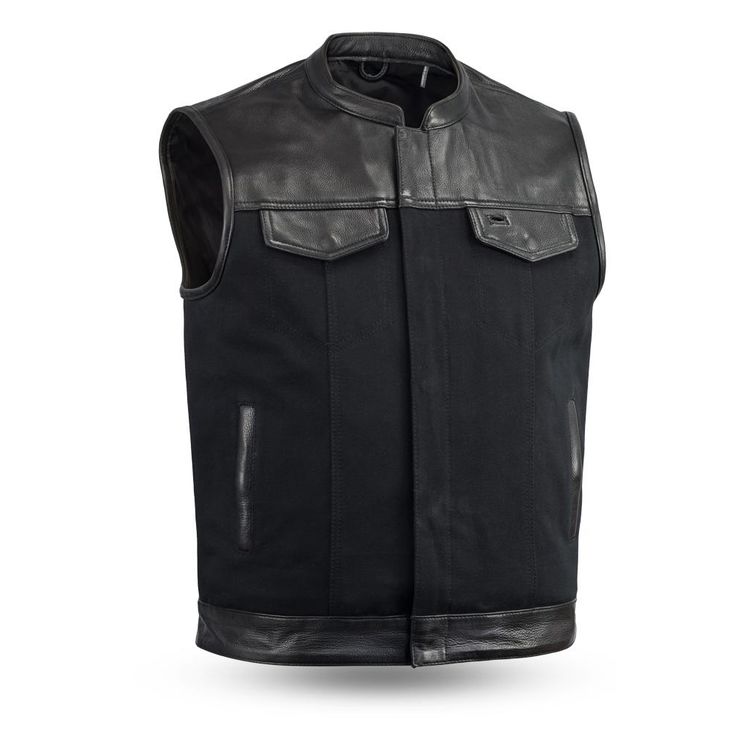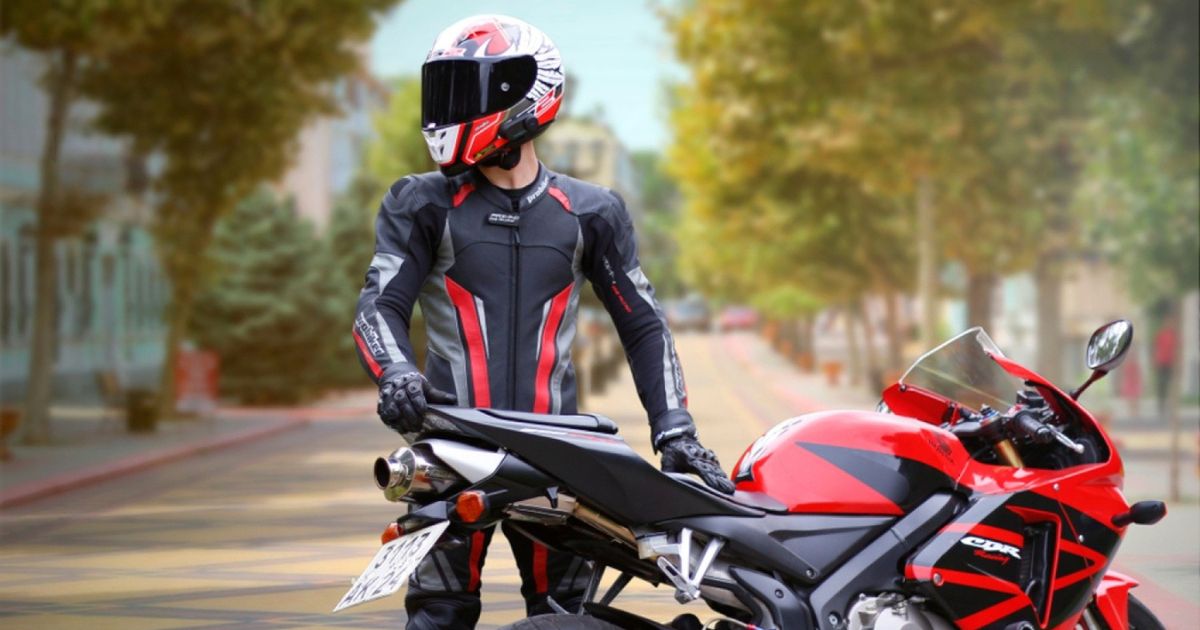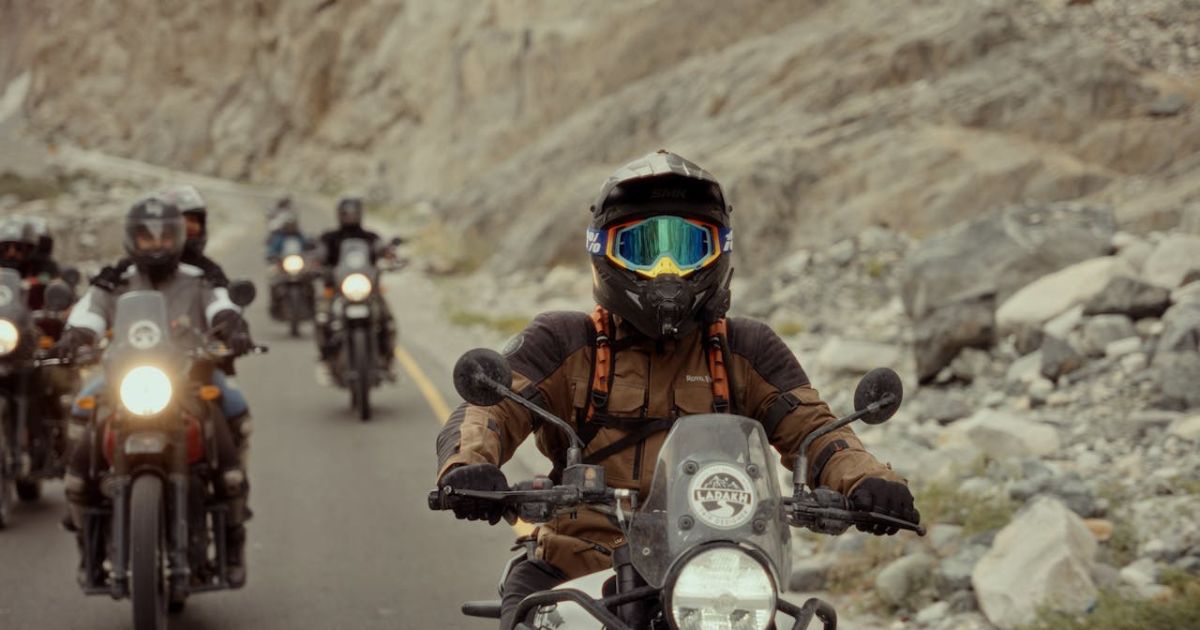
Best Motorcycle Vests 2026: Safety, Style & Comfort
left for contents
Motorcycle vests aren’t just a fashion statement – the right one can be the difference between loving every mile and swearing off riding altogether. This guide isn’t another list of generic recommendations; it’s a deep dive into the vests that actually make a difference. By the end you’ll know which vest will keep you safe on back‑country trails, which will cool you down in tropical heat, and which ones are built for the swagger of cruiser life.
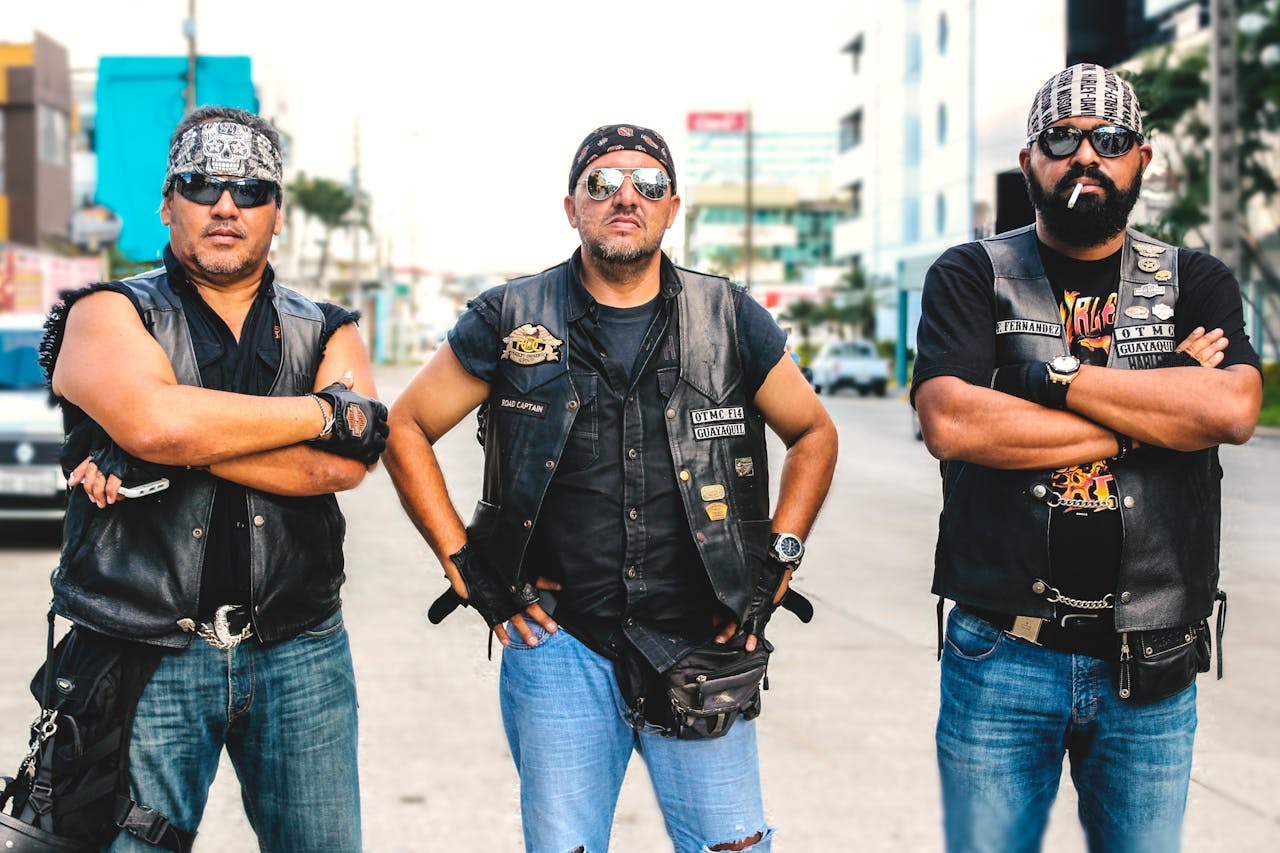
Here’s a little controversy to get your blood pumping:
- A vest can save your life just as effectively as a jacket. Airbag vests deploy faster than your reflexes and cover vital areas like the chest, ribs and spine.
- Not every vest is meant to be worn under leather. Modern canvas and leather airbag systems are designed to look like regular streetwear while hiding cutting‑edge electronics.
- A cooling vest can beat riding shirtless in the summer. Water‑based vests release a fine mist to regulate your core temperature, limiting heat exhaustion during scorching rides.
- Club‑style leather vests aren’t just for style; some even accept CE armour or feature mechanical airbags. The old‑school silhouettes are hiding some new‑school tech.
Curious? Let’s explore which vest fits each riding scenario and then break down the pros and cons of our favorite picks.
Which Vest Fits Which Riding Scenario?
The term “motorcycle vest” covers a surprising range of gear, from high‑tech airbag systems to lightweight cooling garments. Here’s a quick guide to where each category excels:
- Algorithm‑based airbag vests: Ideal for commuters, tourers and riders who want MotoGP‑level protection without committing to a full race suit. These vests use accelerometers and gyroscopes to detect a crash and inflate within milliseconds. They can be worn over or under a jacket, and some are styled like casual canvas or leather outerwear.
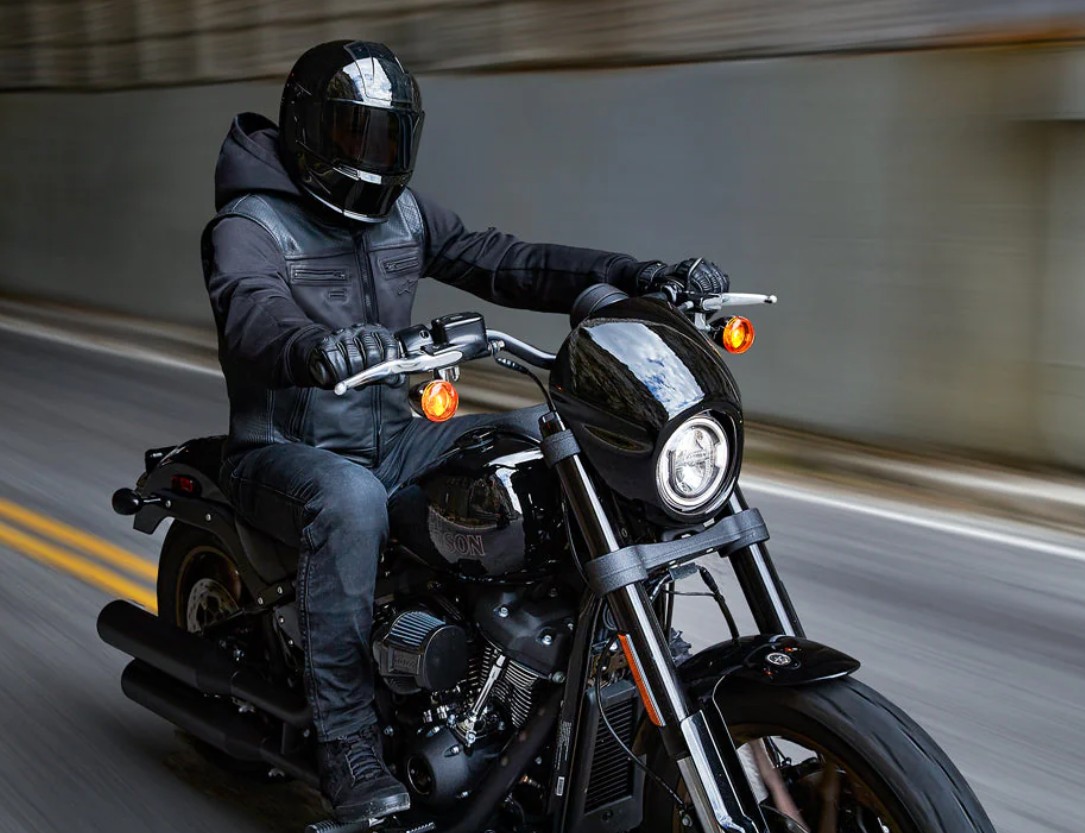
- Mechanical (tethered) airbag vests: Best for riders who want simplicity. They use a lanyard attached to the bike; if you’re ejected, a CO₂ canister inflates the vest in about 0.1 second. There are no batteries to charge and no phone apps to pair.
- Cooling vests: Built for hot climates. A water chamber releases a light mist against your core, reducing your temperature by evaporative cooling. They’re perfect for desert rides, tropical commutes or long days in off‑road gear.
- Leather and hybrid club‑style vests: The traditional cut favored by cruiser riders and club members. These vests usually focus on storage, style and patch space, but some now include back‑protector pockets and reflective trim. Hybrid versions pair leather at the shoulders and hem with canvas bodies for a lighter feel.
Quick Matching Table
To give you a head‑start, here’s a cheat sheet before we dive into individual reviews:
| Riding scenario | Best vest type | Rationale |
|---|---|---|
| Daily street riding/commuting | Algorithm‑based airbag vest (Alpinestars Tech‑Air 3 V2 Canvas and Leather) | AI‑driven crash detection, full chest and back coverage, can be worn under or over a jacket. |
| Long‑distance touring | Mechanical airbag vest (Helite Turtle 2) | No charging needed; mechanical tether deploys in 0.1 s; can be reused by replacing CO₂ cartridge. |
| Summer/heatwave riding | Evaporative cooling vest (Alpinestars Cooling Vest) | Liquid cooling system releases mist to regulate core temperature and limit heat exhaustion. |
| Cruiser style & club riding | Leather vests with patch panels (Street & Steel Redwood 2, Anarchy) | Drum‑dyed cowhide, pockets for concealed carry, easy patch access. |
| Hybrid canvas/leather or patriotic style | First Mfg Born Free USA or 49/51 Vest | Drum‑dyed cowhide and heavy hitter canvas for durability; American‑flag lining and concealed carry pockets. |
With those quick picks in mind, let’s explore each vest in detail. I’ll share how they perform on the road, what’s great about them, and where they come up short (with either a silver lining or an alternative option).
Alpinestars Tech-Air 3 V2 Canvas Airbag System – Smart Armor with Urban Style
Best for: Riders who want discreet protection that fits into street style.
Imagine slipping on what looks like a casual canvas vest — maybe one with club patches — but hidden beneath is a fully autonomous airbag system ready to react. That’s the idea behind the Tech-Air 3 V2 Canvas.
Gone are the days of purely race-style shells. The V2 canvas version is built to blend in, with stretch nylon canvas that stands up to daily wear. It retains its slim profile so you can layer it under a jacket or zip it over a hoodie. Patches and embroidery are still supported thanks to careful stitching and placement.

Protection & Technology
The V2 Canvas uses six integrated sensors (three accelerometers and three gyroscopes) to power the crash-detection algorithm that triggers inflation when needed. The vest is autonomous — no cables or attachments to your bike required. In milliseconds, the airbag inflates to protect both chest and back. Side-stretch panels allow for expansion, and a built-in back-protector pocket adds optional support.
Its electronics are sealed for all-weather use, with waterproof housing around the control unit. Battery life is rated at up to 40 hours of ride time on a full charge, recharged via USB. A key upgrade in the V2 is the user-replaceable inflator, meaning you no longer need to send the vest to a service center after deployment.
On the Road
Riders testing the V2 Canvas highlight how naturally it layers under jackets, with stretch panels improving comfort and mobility. The canvas shell breathes well and feels lighter than leather, making it suitable for warmer conditions. Some testers mention that the fit feels snug at first but settles in after a few rides. For added protection, the back pocket can accept a CE Level 2 back protector insert.
A lightweight, wearable airbag vest offering full chest and back protection in under 50 ms. Fully automatic and activates just by closing the zipper. Also available in tan or as a leather vest.
- Full chest and back impact protection
- Can be worn over a jacket (most airbags can't)
- Weatherproof materials for all-season use
- Less coverage than Tech Air 7X and 5
Downsides & Silver Linings
The Tech-Air 3 V2 is built for street and touring, not aggressive off-road use. Some riders notice a slight bulge from the inflator under tight jackets, so sizing and layering matter. The canvas version offers classic styling but less airflow than the ripstop variant. On the plus side, the new user-replaceable inflator makes maintenance simple and affordable. For riders who prefer a mechanical, no-charging option, the Helite Turtle 2 remains a solid alternative.
Alpinestars Tech-Air 3 V2 Leather Airbag System – Classic Looks, Smart Protection
Best for: Riders who want abrasion resistance and timeless aesthetics, with advanced airbag tech.
For those who prefer leather, the Tech-Air 3 V2 Leather keeps all the V2 upgrades but wraps them in a refined, premium hide shell. It delivers the same sensor-based protection, now with added abrasion defense and a more structured fit.
The V2 Leather is fully autonomous, deploying in milliseconds without any tether or wiring. It supports both under- and over-jacket wear, provided your outerwear allows expansion. Like the canvas model, it’s equipped with waterproof electronics, Bluetooth connectivity, and a 40-hour battery life. It’s also EN1621-4 Level 2 certified for both chest and back impact protection.
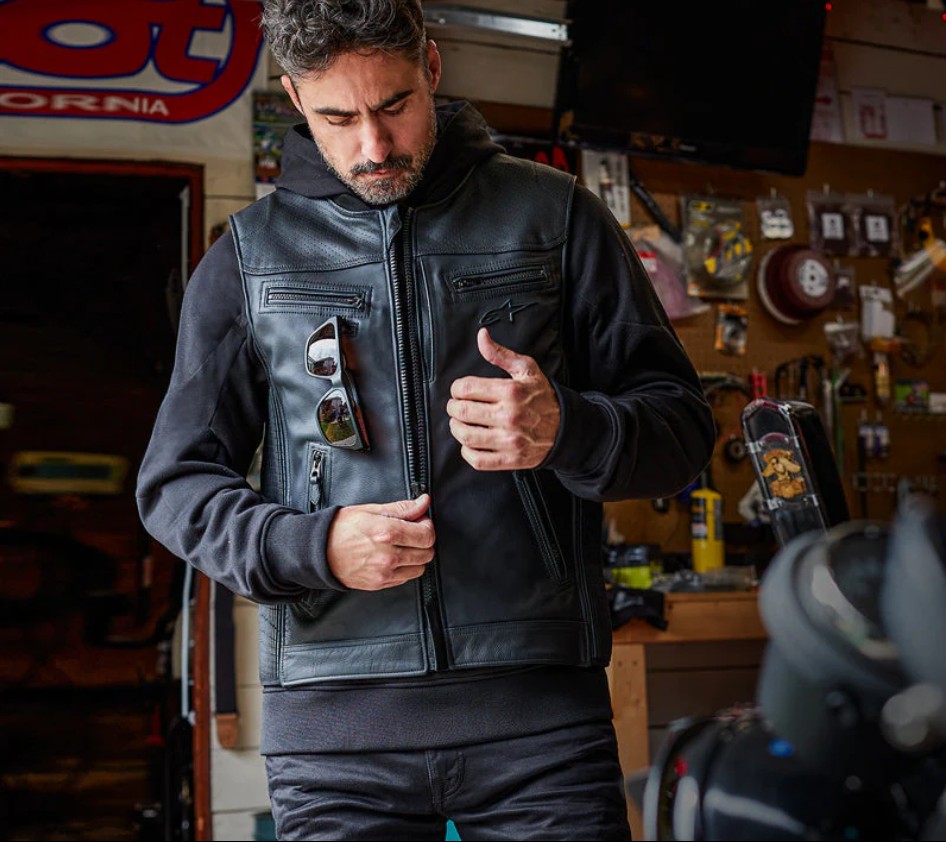
On the Road
Riders appreciate how the leather version holds its shape and provides extra wind protection during cooler rides. While heavier than the canvas version, it offers a premium, reassuring feel. Because leather retains more heat, pairing it with a vented or mesh base layer helps in warmer climates. Some riders mention slight pressure from the inflator when worn over thicker jackets, so correct sizing is essential.
The Alpinestars Tech-Air 3 V2 Leather Vest is a sleek, autonomous airbag system designed to be worn over or under a jacket, offering rapid chest and back protection for street riders.
- Fast deployment (within milliseconds)
- Comfortable over/under fit
- 40-hour battery life
- Lacks shoulder/neck coverage
- Requires periodic servicing
- Higher price point
Downsides and Alternatives
Leather traps more heat and costs more than textile options, but it offers unmatched style and abrasion resistance. The structured fit can feel heavier in summer, yet it adds stability and premium feel on cooler rides. For riders who prefer a lighter, low-maintenance option, the Tech-Air 3 V2 Canvas delivers similar protection with better airflow.
Helite Turtle 2 Airbag Vest – Mechanical Simplicity for the Open Road
Best for: Riders who want a reliable, maintenance‑free airbag vest that works with any jacket.
The Helite Turtle 2 is the anti‑tech tech vest. Instead of algorithms and sensors, it uses a lanyard tethered to your bike. When you’re thrown from the seat, the tether triggers a CO₂ canister and the vest inflates around your torso. It’s simple, effective and doesn’t rely on batteries or software.
Why It Works
The Turtle 2 is constructed from 600‑denier fabric with 3D mesh and integrates a SAS‑TEC level 2 back protector. The back protector distributes impact forces across the entire airbag – imagine a turtle shell protecting your spine. When the lanyard pulls free, the vest inflates in roughly 0.1 second. After a deployment, just replace the CO₂ cartridge and you’re ready to go again.
Reflective strips on the shell improve visibility at night, and a 600‑denier outer paired with a mechanical trigger means you don’t have to worry about waterproof USB ports or firmware updates. The vest’s mechanical nature makes it popular with touring riders and commuters alike.
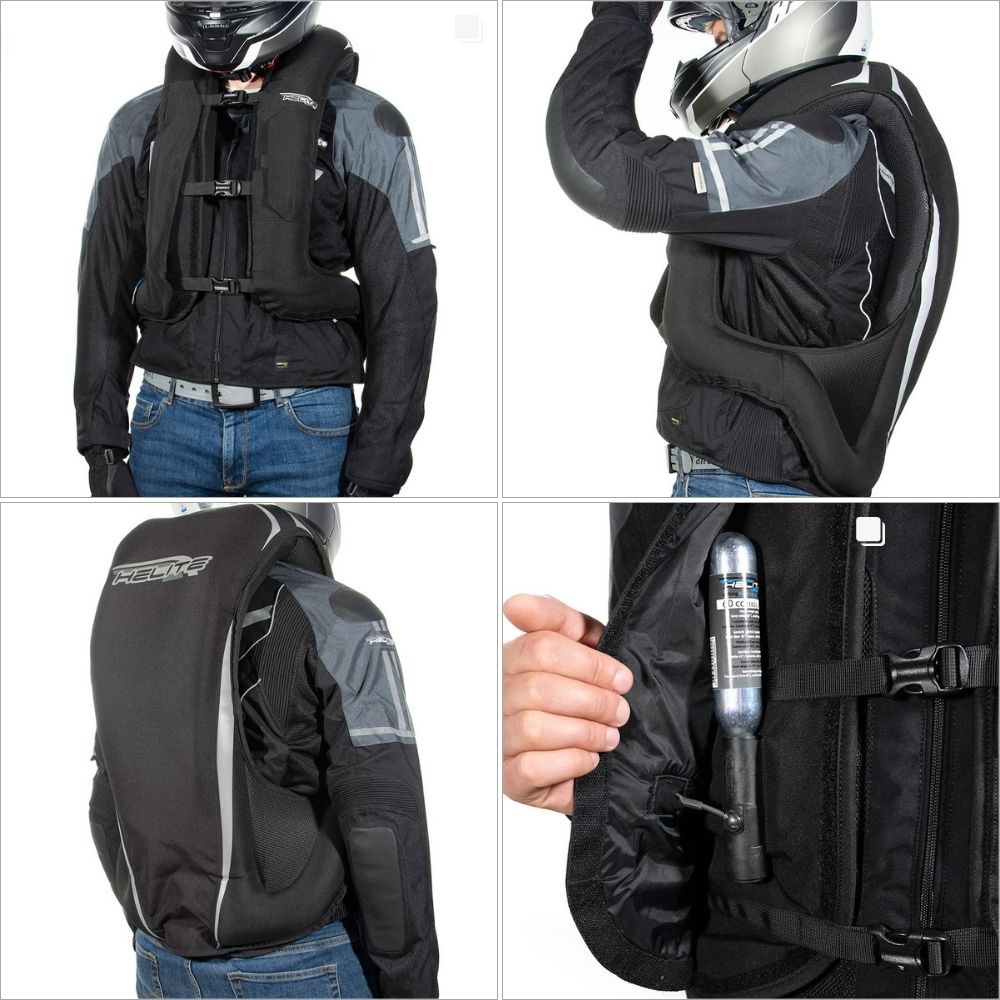
On‑Bike Experience
Riders consistently praise the Helite Turtle 2 for its comfort and ease of use. Many note that it fits naturally over mesh or textile jackets and doesn’t restrict movement, even on long rides. A reviewer on NC700-Forum said it “felt comfortable and provided incredible protection” throughout a 2,000-mile trip, while several RevZilla users highlight how the 3D mesh interior keeps air circulating during hot days.
Because it’s mechanically triggered, there’s no battery to charge — just clip in and ride. The sturdy fasteners are easy to operate with gloves on, and while the pocket space is minimal, most riders agree the overall simplicity and reliability make it a go-to vest for touring and commuting alike.
Advanced tethered airbag vest offering wrap‑around torso protection and quick reset ability post‑deployment.
- High‑speed inflation cushions chest and back
- Tether system stays snug and nonrestrictive
- Rearm simply with affordable cartridge
- Lightweight design fits over leathers
- Reusable airbag with quick-reset process
- Tether-trigger style only deploys on bike
- May fit awkwardly without a race hump
Drawbacks and Workarounds
A tethered system means you have to remember to clip in every time you ride. Forget the lanyard and you’ve got a heavy vest with no protection. Some riders worry about accidental deployments when standing on the pegs or stretching at a stop, but the required force is significant enough that normal movement doesn’t trigger it. If you want a system that doesn’t rely on a tether, the Tech‑Air series offers algorithm‑based airbags. Conversely, the Helite is perfect if you don’t want to fuss with charging or apps.
Our Review: Learn more about how the Helite Turtle 2 stacks up against other top airbag systems in our full guide, best motorcycle airbags.
Alpinestars Cooling Vest – Beat the Heat Without Riding Shirtless
Best for: Hot‑weather riders, off‑roaders and anyone prone to overheating.
If you’ve ever ridden through a Thailand summer or across the Mojave, you know how oppressive heat can sap your focus. Sweating under heavy gear is miserable and dangerous. That’s where the Alpinestars Cooling Vest steps in. It uses a refillable water chamber to release a fine mist against your midsection, lowering your core temperature and reducing fatigue.
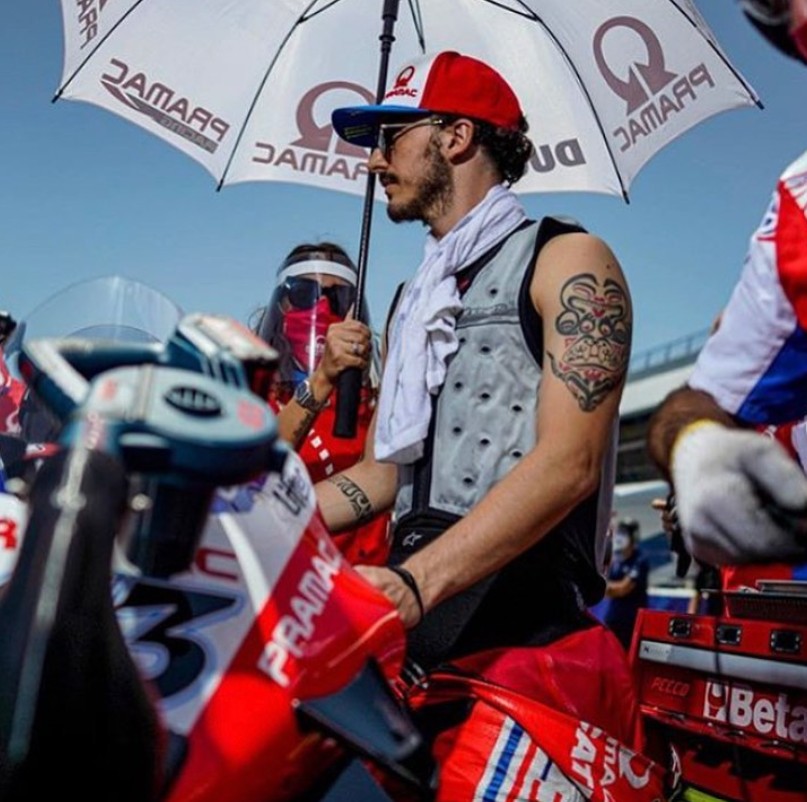
How It Works
The vest features a liquid cooling system that evenly releases water droplets against your torso. As the water evaporates, it pulls heat away from your body. Stretch inserts ensure the vest conforms to your shape for maximum contact and airflow. Perforations act as gussets to keep the vest’s shape and allow air to circulate. A quick‑fill port means you can top up the water reservoir in seconds without making a mess.
Features Riders Love
- Heat exhaustion mitigation: The mist helps regulate your vascular system, limiting the effects of heat exhaustion.
- Lightweight design: Despite carrying water, the vest remains relatively light thanks to three‑layer textile construction and a moisture‑wicking fleece lining.
- Refillable reservoir: You can ride for hours before needing a refill, and the wide mouth makes refills quick.
- Ventilation: Designated air ports promote breathability even when the vest is soaked.
A water-filled, lightweight evaporative vest that helps lower core heat on hot rides, designed to slip underneath your jacket and promote thermal comfort.
- Effective core cooling (up to ~15 °C drop reported)
- Easy, no-mess refill with a simple back port
- Ventilation ports and stretch panels aid airflow
- Moisture-wicking fleece lining keeps you dry
- Cooling effect fades after several hours
- Must be worn snug—loose fit reduces efficiency
Considerations and Alternatives
The cooling vest is not protective gear – there’s no armor or abrasion resistance. It’s designed to be worn under a jacket, so you still need a protective outer layer. Additionally, the vest’s cooling effect depends on evaporation; in humid climates its effectiveness is reduced.
If you ride mostly in high humidity, consider a mesh jacket with built‑in venting instead. For those who want heating instead of cooling for winter rides, check out heated vest liners like the Gerbing 12 V Heated Vest in our full gear guide.
Street & Steel Redwood 2 Leather Vest – Vintage Style With Modern Utility
Best for: Cruiser riders and anyone who wants classic looks with hidden functionality.
The Street & Steel Redwood 2 proves that you can have your vintage cake and eat it too. At first glance it’s a traditional leather vest with a single panel back. Underneath the retro exterior are thoughtful features for modern riders.
Construction and Comfort
The Redwood 2 is built from natural drum‑dyed matte‑finished 1.1 mm cowhide. A black micro‑mesh lining prevents the leather from sticking to your skin and helps it break in quickly. The single back panel has a zippered opening so you can easily add club patches.
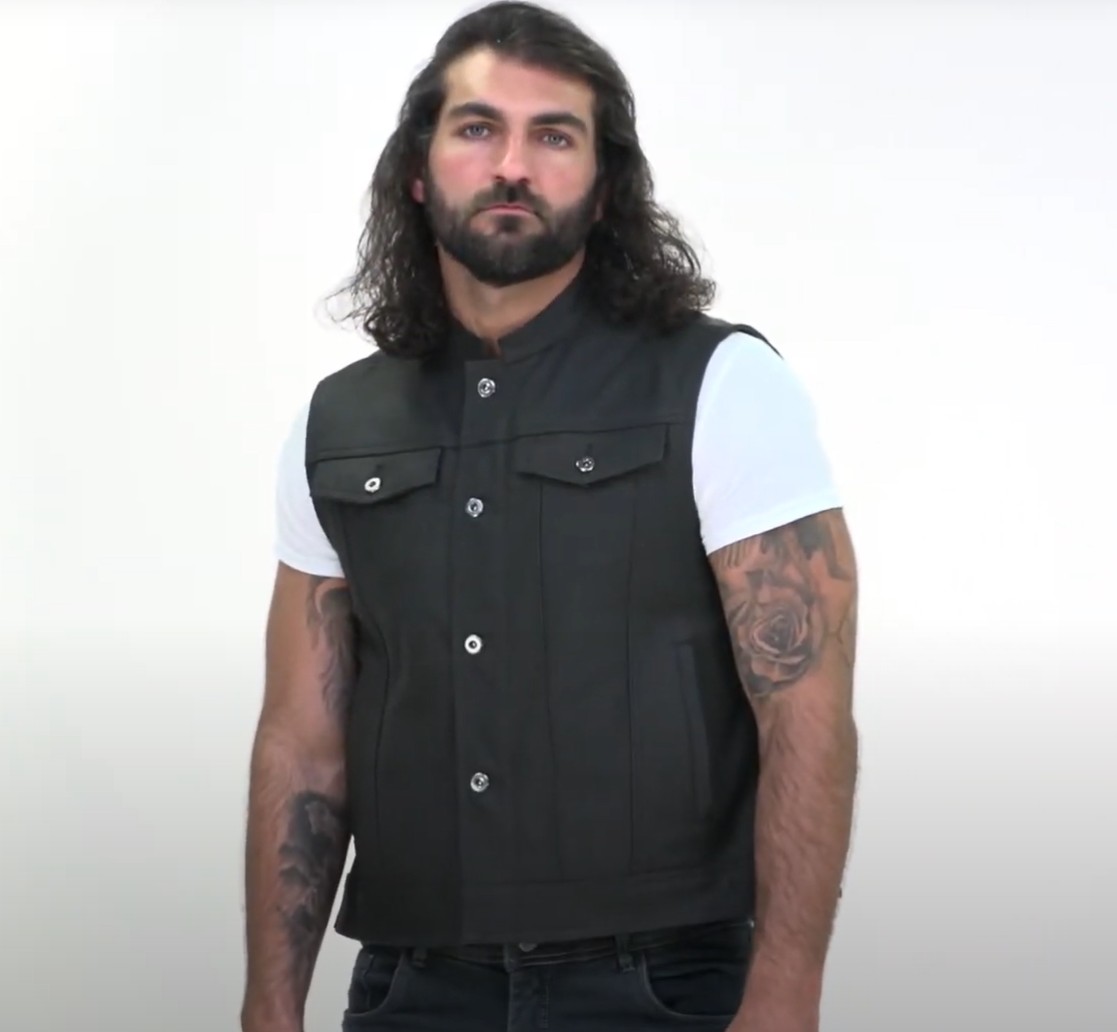
Storage and Protection
This vest isn’t just for looks. Inside you’ll find a back pocket designed to accept a CE back protector (sold separately). Two concealed carry pockets allow discreet storage of a small firearm or other valuables. There are also two hand‑warmer pockets, two chest pockets (one with a sunglass holder slot), and four interior pockets. A short collar and jean‑jacket silhouette complete the laid‑back look.
On the Road
Riders describe the Redwood 2 as one of the most comfortable leather vests right out of the box. Many mention that the micro-mesh lining keeps it from sticking to shirts, even in warm weather, while the 1.1 mm cowhide softens quickly after a few rides. Several reviewers highlight the practical storage options and appreciate the discreet back-protector pocket for extra safety. The vest feels sturdy yet flexible, making it ideal for cruiser and touring use.
A few riders note that the leather can get warm in peak summer heat, but pairing it with a breathable base layer or opting for the Denim Redwood 2 version improves airflow.
Vintage-style leather vest built with practicality in mind—it delivers style, concealed carry, and a dedicated back protector slot in one classic package.
- Durable 1.1 mm drum-dyed cowhide resists wear
- Micro-mesh lining keeps you cooler on warm rides
- Single-panel back offers room for custom patches
- Dual concealed carry pockets + utility storage
- Limited ventilation—can feel hot in summer
- No built-in chest armor, only back protector slot
Downsides and Alternatives
The stock spine protector is not CE certified, so serious safety‑conscious riders should budget for an upgrade. The vest also lacks the micro‑mesh lining of the Redwood 2, so break‑in may take longer. If you want more pockets and patch space, the Redwood 2 is a better choice. However, if you prefer a leaner look and reflective detailing, the Anarchy delivers.
Street & Steel Anarchy Leather Vest – Classic Club Style With Adjustable Fit
Best for: Riders seeking a minimalist leather vest with adjustable comfort.
When you want a straightforward leather vest but still value safety, the Street & Steel Anarchy offers a compelling package. It’s built from natural drum‑dyed leather and features a zippered rear access panel for easy patching.
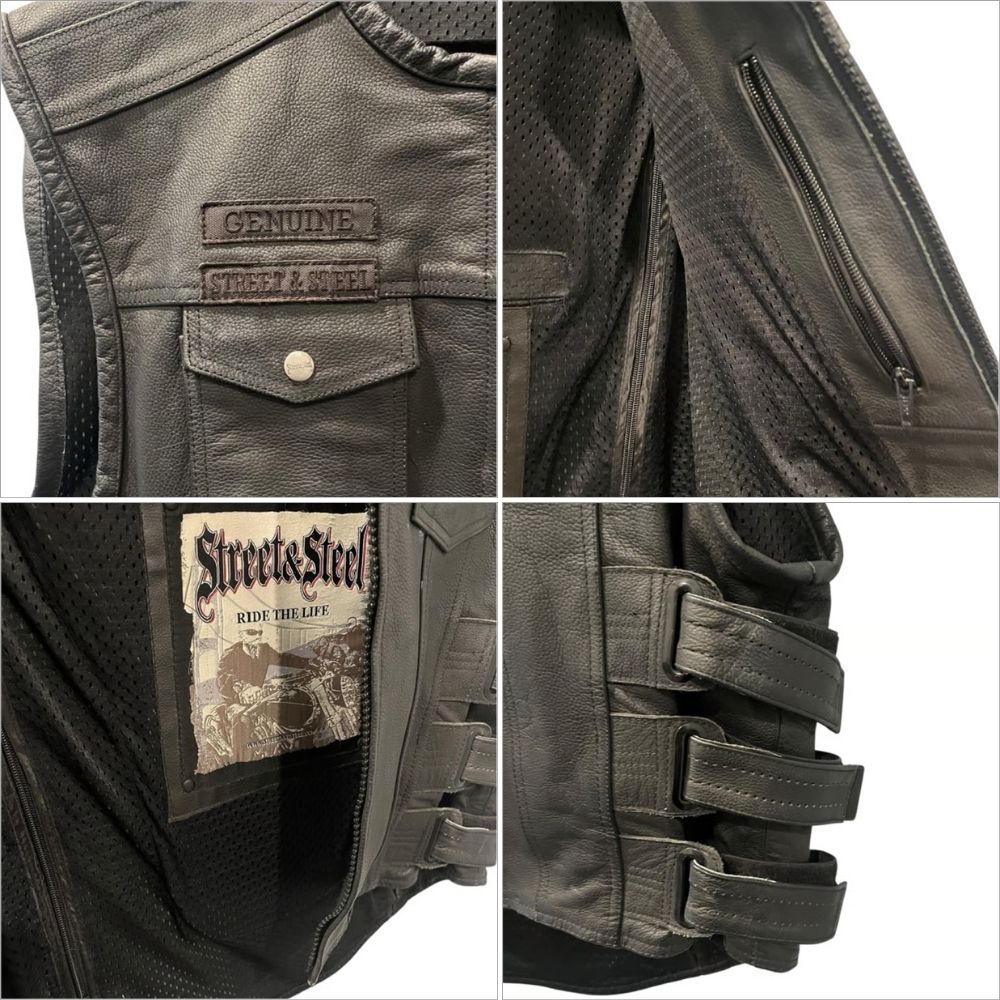
Protection and Safety
The vest comes with a removable dual‑density spine protector (not CE rated) and a pocket to upgrade to a CE back protector. Reflective trim adds a touch of visibility for night rides.
Comfort and Fit
An EZ FIT adjustable waist and low‑restriction collar allow you to fine‑tune the fit for comfort. Customers report that the vest runs small and recommend sizing up. When I tried it on over a sweatshirt, I found the sides easy to adjust thanks to the side laces.
A rugged leather vest with club-style swagger and hidden utility, the Anarchy blends style with practicality using a rear patch panel and spare protector pocket.
- Runs small — size up for proper fit
- Removable spine pad with upgrade option
- EZ-FIT waist for adjustable comfort
- Zippered back panel for easy patching
- Stock spine protector is not CE rated
- Leather can feel stiff until broken in
Downsides and Alternatives
The stock spine protector is not CE certified, so serious safety‑conscious riders should budget for an upgrade. The vest also lacks the micro‑mesh lining of the Redwood 2, so break‑in may take longer. If you want more pockets and patch space, the Redwood 2 is a better choice. However, if you prefer a leaner look and reflective detailing, the Anarchy delivers.
Our Review: Discover how the Street & Steel Anarchy Leather Vest fits into the classic biker aesthetic in our full style guide, 5 Vintage Motorcycle Jacket Looks.
First Manufacturing Born Free USA Vest – Patriotic Club Style With Satin Lining
Best for: Riders looking for classic club‑style leather with an American‑flag motif and ample storage.
The Born Free USA vest marries old‑school patriotism with modern convenience. Constructed from drum‑dyed naked cowhide leather, it features a banded collar, covered snaps and a cropped center zipper. Inside is a satin lining printed with the American flag, plus panels that open for easy patching.
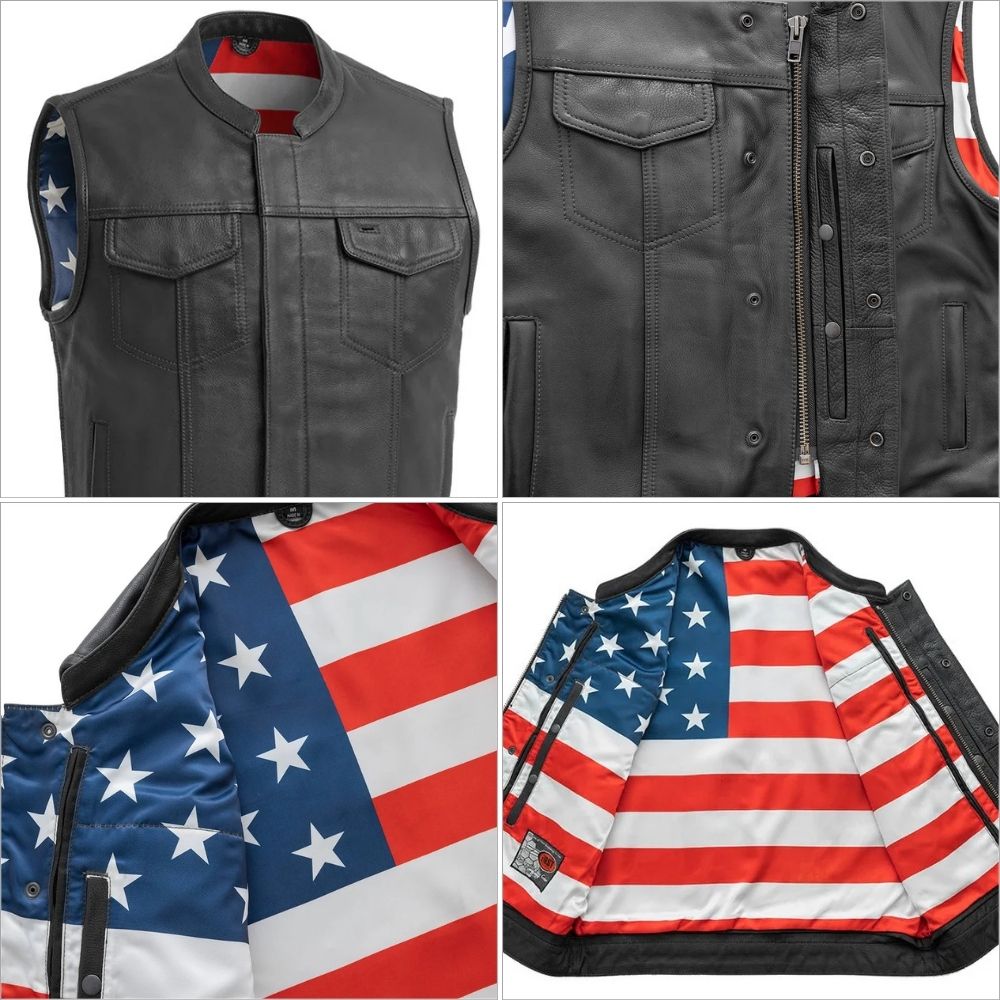
Features That Matter
- Storage: Two buttoned chest pockets and two buttoned slash pockets hold small items. Inside are two concealed carry pockets with tapered holsters for quick access on the left side. There’s also an interior cell phone pocket for modern necessities.
- Single‑panel back: Makes adding large club patches straightforward.
- Satin lining with American flag: Adds comfort and flair, especially when you hang the vest on a chair at your favorite diner.
On the Road
Riders praise the Born Free USA Vest for its supple feel right out of the box — the naked cowhide breaks in quickly and the satin flag lining glides easily over shirts, making it comfortable even in warm weather. Reviewers highlight the vest’s roomy concealed-carry pockets and classic club cut, noting it’s ideal for riders who prioritize style and storage over built-in armor. While it lacks a back-protector pocket, most say it layers well over armored shirts or under riding jackets without feeling bulky.
The overall verdict: timeless design, solid craftsmanship, and a smooth fit that feels premium for the price.
A bold cruiser vest with a patriotic satin lining, the Born Free USA delivers classic club style and practical utility with built-in concealed-carry and patch-ready panels.
- Ample pockets including CCW holsters
- Easy patching with a single back panel
- Satin American-flag lining adds flair
- Solid 1.1–1.2 mm cowhide offers durability
- Holster pocket fits only smaller handguns
- Collar may rub the neck on long rides
Downsides and Silver Linings
While the Born Free USA Vest delivers standout style, it lacks built-in armor pockets for riders who prefer added protection. The satin flag liner also isn’t for everyone—some riders may find it too bold for daily wear.
For those seeking similar craftsmanship with CE-protector compatibility, the Street & Steel Redwood 2 or First Manufacturing 49/51 vests are solid alternatives, offering classic looks with optional armor upgrades. If you love the fit but prefer something subtler, the First Manufacturing Villain (not covered here) delivers a similar cut without the patriotic motif.
First Manufacturing 49/51 Vest With Collar – Hybrid Canvas Meets Leather
Best for: Riders who want a lighter vest without giving up durability or storage.
Hybrid vests have become popular because they balance weight and protection. The First Manufacturing 49/51 gets its name from the split of materials: heavy duty canvas on the torso and diamond cowhide on the shoulders and hem.
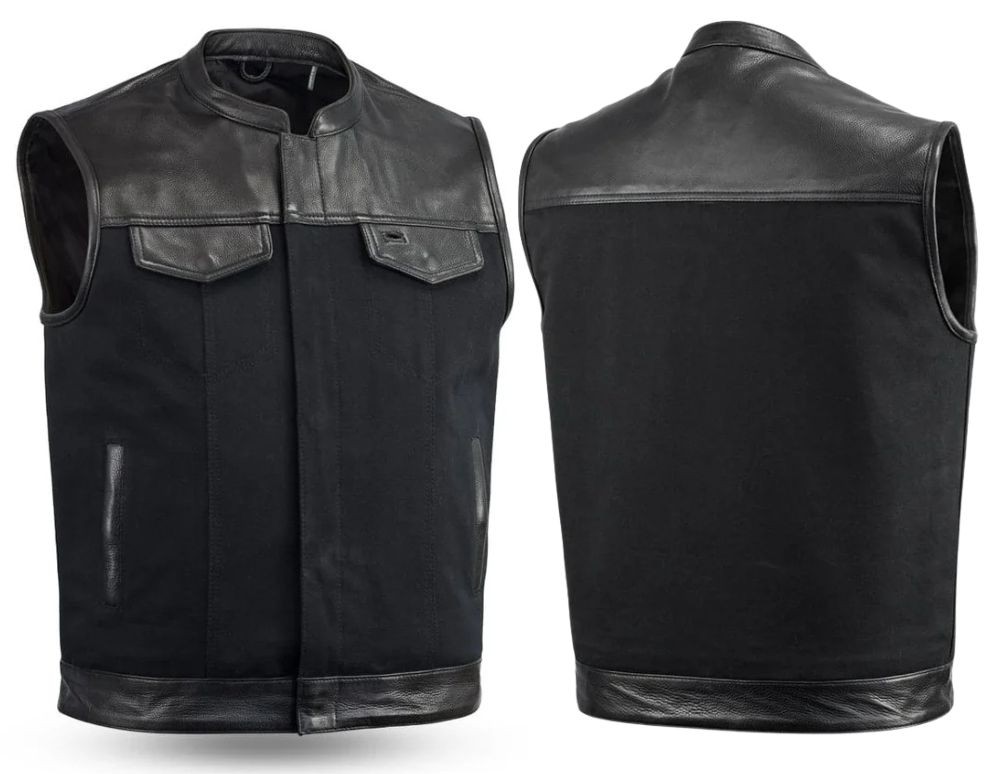
Design and Features
- Heavy Hitter canvas body with leather accents: The 20 oz canvas holds its shape while the cowhide shoulders provide abrasion resistance.
- Single panel back: Allows for easy patching and personalization.
- Stand‑up preacher collar: Offers extra coverage at the neck without the bulk of a full collar.
- Storage galore: Two snap chest pockets, two slash pockets, an interior cell phone pocket and concealed carry pockets with bullet snaps and a tapered holster.
- Hidden zipper and snaps: Keep wind out while maintaining a clean look.
- Lifetime warranty on hardware: Shows confidence in the quality.
Riding Impressions
Riders who’ve tried the 49/51 Vest say it strikes a great balance between airflow and structure. The Heavy Hitter canvas breathes noticeably better than full leather, while the cowhide shoulders and hem add durability where it counts. Many appreciate how the vest feels broken-in after a few rides and how the preacher collar helps block wind on morning rides. The large concealed-carry pockets double nicely for everyday storage — phones, tools, or small cameras fit easily. Though it lacks abrasion protection on its own, most riders pair it with an armored shirt or denim jacket underneath for added safety.
A rugged hybrid vest blending canvas and leather with concealed carry options and a collar — offering durability and style in one club-ready package.
- Leather shoulders and hem increase abrasion resistance
- Multiple concealed-carry and storage pockets
- Single-back panel allows full patch customization
- Preacher collar adds wind protection for the neck
- Canvas body gives less protection than full leather
- Snug fit—may feel tight until broken in
Downsides and Silver Linings
Canvas requires more break-in than leather and can feel stiff at first. Wash it or wear it often to soften the fibers. The vest doesn’t come with a back-protector pocket, so you’ll need separate armor. On the other hand, its hybrid design results in a lighter feel and better breathability than full leather – great for warm climates.
If you prefer a cleaner neckline, the 49/51 no-collar version offers the same hybrid construction with a more streamlined look. Riders who want maximum abrasion resistance or a full-leather aesthetic can consider the Born Free USA Vest, which provides a tougher exterior and classic club style while trading off some airflow.
Comparison Table
| Product | Category / Best for | Key features | Price (USD) |
|---|---|---|---|
| Alpinestars Tech‑Air 3 V2 Canvas | Algorithm-based airbag; urban and touring riders | Updated V2 model with stretch canvas shell; 6 motion sensors and AI algorithm; full chest/back protection; user-replaceable inflator; Bluetooth app connectivity; 40-hour battery life | ≈ $699 |
| Alpinestars Tech‑Air 3 V2 Leather | Algorithm-based airbag; street + cruiser style | Premium drum-dyed leather shell; same AI airbag tech as Canvas V2; EN1621-4 Level 2 chest/back protection; waterproof electronics; USB charging; classic fit for layering | ≈ $799 |
| Helite Turtle 2 | Mechanical airbag; touring & commuting | Tethered CO₂ system deploys in ~0.1 s; 600‑D shell and SAS‑TEC level 2 back protector; reusable canister; reflective strips | ≈ $750 |
| Alpinestars Cooling Vest | Heat management; off‑road & hot climates | Liquid cooling mist system; stretch inserts and perforations for fit; moisture‑wicking fleece lining | ≈ $200 |
| Street & Steel Redwood 2 | Cruiser style & utility | 1.1 mm drum‑dyed cowhide; micro‑mesh lining; back protector pocket; concealed carry pockets and multiple storage | ≈ $160 |
| Street & Steel Anarchy | Minimalist leather with adjustability | Drum‑dyed leather; removable spine protector with upgrade pocket; reflective trim; EZ FIT adjustable waist | ≈ $150 |
| First Mfg Born Free USA | Patriotic club style | Naked cowhide; banded collar & concealed snaps; two concealed carry pockets & cell phone pocket; American‑flag satin lining | ≈ $180 |
| First Mfg 49/51 Vest | Hybrid canvas & leather | Heavy hitter canvas body with leather shoulders; preacher collar; YKK zips and hidden snaps; concealed carry pockets; lifetime hardware warranty | ≈ $150 |
Prices are approximate and may vary depending on retailer promotions.
Buying Guide: How to Choose the Right Motorcycle Vest
The best motorcycle vest for you depends on your riding style, climate, and personal preferences. Use the following considerations to narrow down your options.
Purpose & Protection
- Impact protection: If safety is your top priority, opt for an airbag vest. Algorithm-based systems like the Tech-Air series provide full chest and back coverage and inflate automatically. Mechanical systems like the Helite deploy quickly without batteries.
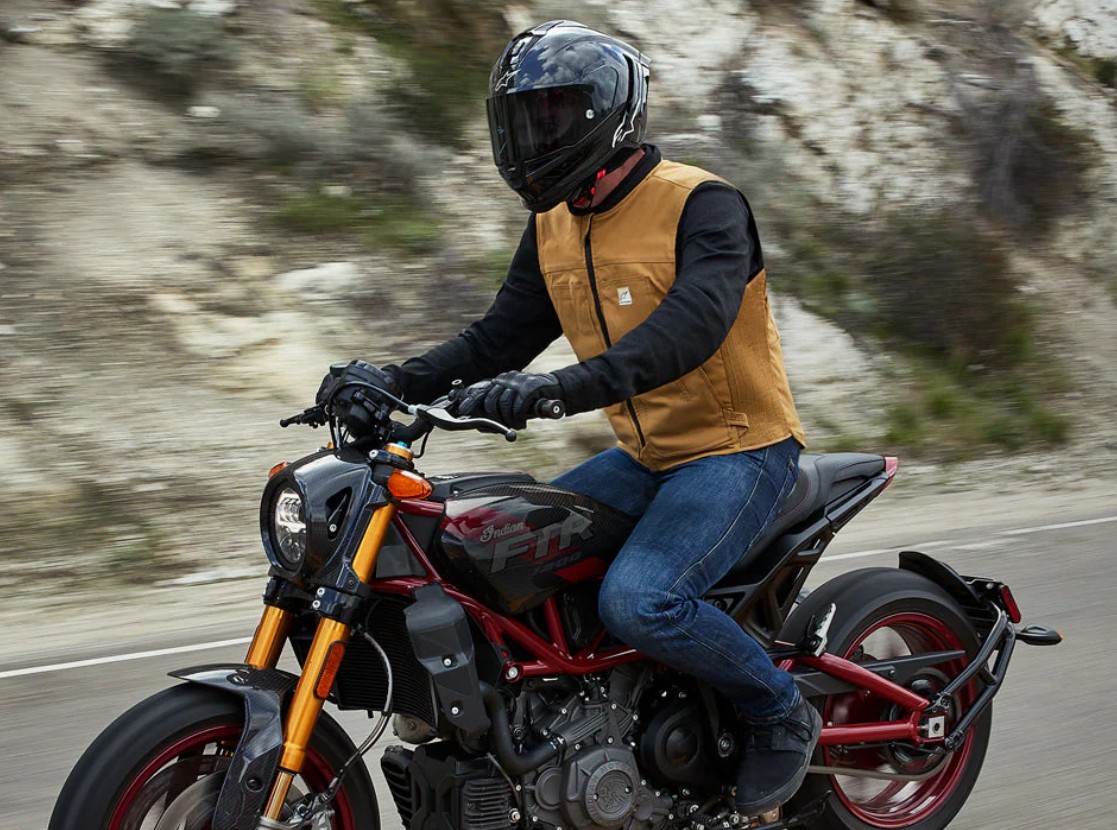
- Abrasion resistance: Leather offers the best abrasion protection. Look for 1.0–1.2 mm drum-dyed cowhide like that on the Redwood 2. Hybrid canvas/leather vests sacrifice some abrasion resistance for lighter weight.
- Cooling vs. heating: If you ride in extreme heat, an evaporative cooling vest can reduce fatigue. For cold weather, consider a heated vest liner instead.
Fit & Comfort
- Under or over? Airbag vests need room to inflate. Check sizing charts and ensure your jacket can expand by at least 4 cm around the chest. Mechanical vests like the Helite are worn over jackets and require less precision.
- Adjustability: Vests like the Street & Steel Anarchy have adjustable waists for a tailored fit. Canvas vests may require break-in; leather vests mold to your body over time.
- Lining: Micro-mesh or satin linings enhance comfort and help with airflow.
Storage & Features
- Pockets: Decide how much storage you need. Concealed carry pockets are common in club-style vests. Look for zippered interior pockets for valuables.
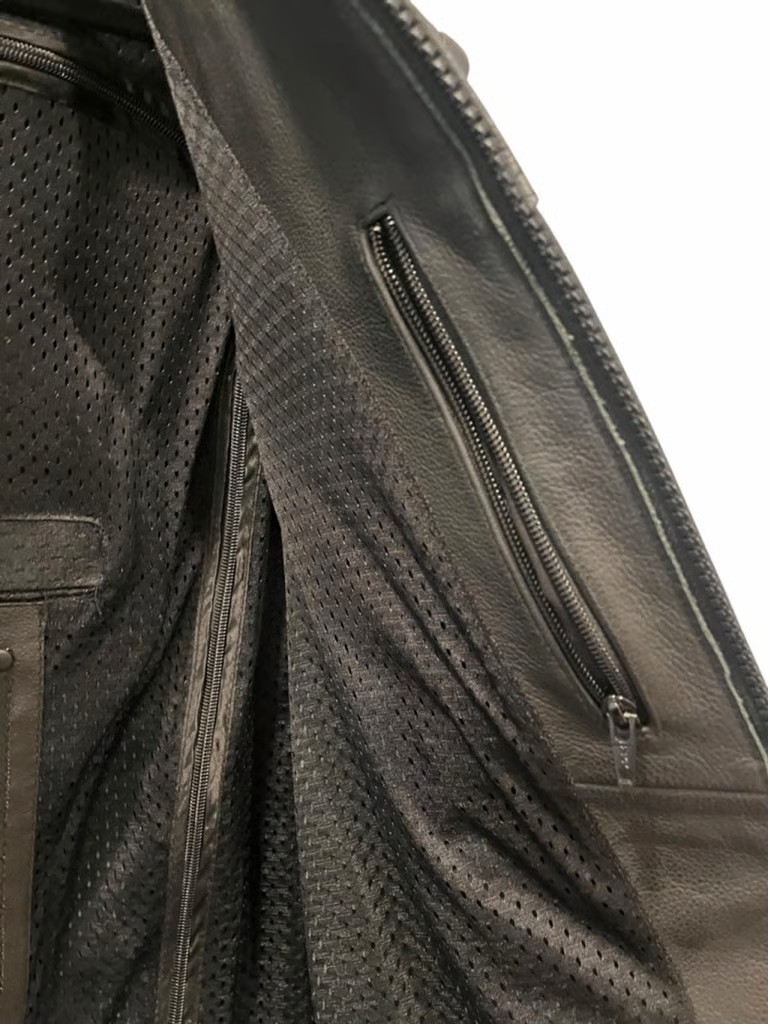
- Patch panels: Single-panel backs make it easy to sew on patches.
- Reflectivity: Reflective trim enhances nighttime visibility.
- Connectivity: Some airbag vests sync with smartphone apps for diagnostics.
Maintenance & Cost
- Charging and updates: Algorithm-based airbags need regular charging and may receive firmware updates. Check battery life (e.g., ~40 hours on the Tech-Air 3).
- Canister replacement: Mechanical vests require replacing CO₂ cartridges after deployment.
- Investment vs. replacement: Airbag vests cost more upfront but can save you from hospital bills. Leather vests last for years; hybrid canvas options are affordable but may wear faster.
Style & Personal Expression
Let’s be honest: style matters. If you love the old-school biker look, go for drum-dyed leather with a clean back panel. Want something casual? Choose canvas or hybrid styles that resemble streetwear. Need to show off club colours or travel badges? Look for single-panel backs with zippered access.

Wrapping Up
Motorcycle vests have evolved far beyond club patches and leather swagger. Today, they’re symbols of freedom, utility, and the rider’s connection to the road. Whether you’re carving through desert highways, gliding along coastal curves, or rolling into a mountain sunrise, the right vest becomes part of your story — a second skin that moves with you, mile after mile.
Ride safe. Ride your style. And remember — every road feels better when your gear feels like it was made just for you.
Related
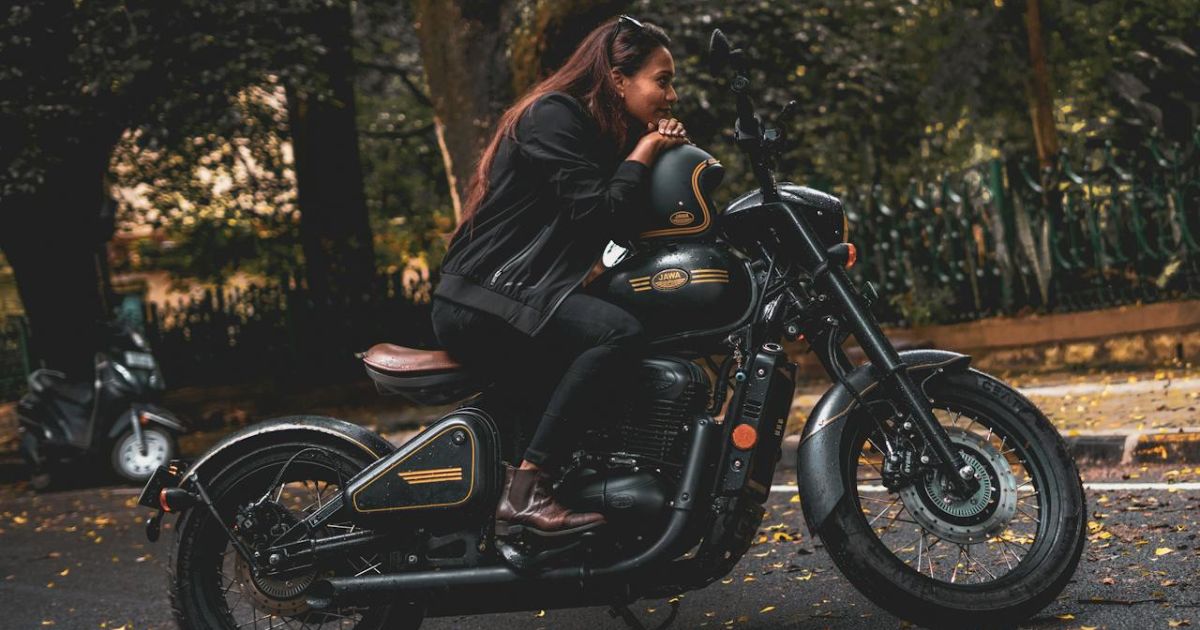
Best Motorcycle Gear for Women: Stylish, Safe & Confident
Discover the best motorcycle gear for women—tested for protection, comfort, and style to keep every rider confident, cool, and safe on the road.

